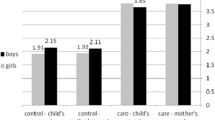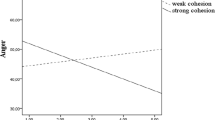Abstract
This study examined the potential risks of maternal and child exposure to traumatic events resulting from political violence, specifically those related to emotional availability, parenting stress and children’s behavioral problems. It also evaluated the feasibility of mitigating these effects through a play-based group intervention for conjoint dyads of mothers and toddlers. Results from 54 dyads show that the higher maternal and especially child exposure to political violence and other trauma, the lower their emotional availability in dyadic interactions (r = .40, p < .01). Emotional availability was associated with the mother’s parenting stress, and both parenting stress and emotional availability were associated with the mother’s perceptions of her child’s behavior problems. Comparisons of observed emotional availability, child behavior problems as perceived by the mother, and reported stress in 28 dyads before and after participating in the intervention suggest that it may be possible to bolster emotional availability and to reduce child’s behavior problems.
Similar content being viewed by others
References
Abidin, R. R. (1995). Parenting stress index, third edition: professional manual. Odessa, Psychological Assessment Resources, Inc.
Abidin, R. R. (2012). Parenting stress index–fourth edition (PSI-4). Lutz, Psychological Assessment Resources, Inc.
Achenbach, T. M., & Rescorla, L. (2000).Child behavior checklist. Burlington.
Bauminger, N., Solomon, M., & Rogers, S. J. (2010). Externalizing and internalizing behaviors in ASD. Autism Research, 3, 101–112. https://doi.org/10.1002/aur.131.
Biringen, Z. (2008). Emotional availability (EA) scales manual. Part, 1, 0–5.
Biringen, Z., Derscheid, D., Vliegen, N., Closson, L., & Easterbrooks, M. A. (2014). Emotional availability (EA): theoretical background, empirical research using the EA scales, and clinical applications. Developmental Review, 34(2), 114–167.
Bowlby, J. (1988). Attachment, communication, and the therapeutic process. A secure base: Parent-child attachment and healthy human development, pp. 137–157.
Chemtob, C. M., Nomura, Y., Rajendran, K., Yehuda, R., Schwartz, D., & Abramovitz, R. (2010). Impact of maternal posttraumatic stress disorder and depression following exposure to the September 11 attacks on preschool children’s behavior. Child Development, 81(4), 1129–1141.
Cohen, E. (2009). Parenting in the throes of traumatic events: relational risks and protection processes. In: J. Ford, R. Pat-Horenczyk & D. Brom (Eds.) Treating traumatized children: risk, resilience and recovery (pp. 72–82). Routledge.
Cohen, E. (2014). “Playing with fire”: Promoting play and playfulness in toddlers and families exposed to recurrent rocket fire. In R. Pat-Horenczyk, D. Brom, C. Chemtob & J. Vogel (Eds.), Helping children cope with trauma: Individual, family and community perspectives (pp. 220–245). Florence: Routledge.
Cohen, E., Pat-Horenczyk, R., & Haar-Shamir, D. (2014). “Making room for play”: An innovative intervention, focused on play and playfulness, for toddlers and families under rocket fire. Clinical Social Work Journal, 42, 336–345. https://doi.org/10.1007/s10615-013-0439-0.
Conway, A., McDonough, S. C., MacKenzie, M. J., Follett, C., & Sameroff, A. (2013). Stress-related changes in toddlers and their mothers following the attack of September 11. American Journal of Orthopsychiatry, 83(4), 536–544. https://doi.org/10.1111/ajop.12055.
Crnic, K., Gaze, C., & Hoffman, C. (2005). Cumulative parenting stress across the preschool period: Relations to maternal parenting and child behavior at age five. Infant and Child Development, 14, 117–132.
Crnic, K., & Low, C.(2002).Everyday stresses and parenting.InM. Bornstein (Ed.)Handbook of parenting: Vol. 5. Practical issues in parenting. Mahwah, Erlbaum.
Dybdahl, R. (2001). Children and mothers in war: an outcome study of a psychosocial intervention program. Child Development, 72(4), 1214–1230.
Dyregrov, A., & Regel, S. (2012). Early interventions following exposure to traumatic events: implications for practice from recent research. Journal of Loss and Trauma, 17(3), 271–291.
Emde, R. N., & Easterbrooks, M. A. (1985). Assessing emotional availability in early development. In W. K. Frankenburg, R. N. Emde & J. W. Sullivan (Eds.), Early identification of children at risk. Topics in developmental psychobiology. Boston: Springer.
Feldman, R., & Vengrober, A. (2011). Posttraumatic stress disorder in infants and young children exposed to war-related trauma. Journal of the American Academy of Child and Adolescent Psychiatry, 50(7), 645–658. https://doi.org/10.1016/j.jaac.2011.03.001.
Gewirtz, A. H., DeGarmo, D. S., & Medhanie, A. (2011). Effects of mother’s parenting practices on child internalizing trajectories following partner violence. Journal of Family Psychology, 25(1), 29–38.
Kaitz, M., Levy, M., Ebstein, R., Faraone, S. V., & Mankuta, D. (2009). The intergenerational effects of trauma from terror: a real possibility. Infant Mental Health Journal, 30(2), 158–179.
Lieberman, A. F. (1996). Aggression and sexuality in relation to toddler attachment: Implications for the caregiving system. Infant Mental Health Journal, 17(3), 276–292.
Lieberman, A. F. (2011). Infants remember: war exposure, trauma, and attachment in young children and their mothers. Journal of the American Academy of Child & Adolescent Psychiatry, 50(7), 640–641. https://doi.org/10.1016/j.jaac.2011.04.009.
Lieberman, A. F., Chu, A., Van Horn, P., & Harris, W. W. (2011). Trauma in early childhood: empirical evidence and clinical implications. Development and Psychopathology, 23(2), 397.
Lieberman, A. F., & Van Horn, P. (2008). Psychotherapy with infants and young children: repairing the effects of stress and trauma on early development. New York, Guilford.
Masten, A. S. (2001). Ordinary magic: resilience processes in development. American Psychologist, 56(3), 227.
McEwen, B. S. (1998). Stress, adaptation, and disease. allostasis and allostatic load. Annals of the New York Academy of Sciences, 1(840), 33–44.
McMahon, C. A., & Meins, E. (2012). Mind-mindedness, parenting stress, and emotional availability in mothers of preschoolers. Early Childhood Research.
Pat-Horenczyk, R., Achituv, M., Rubenstein, Kagan, Khodabakhsh, A., Brom, A.,D.,&Chemtob, C.(2012).Growing up under fire: building resilience in young children and parents exposed to ongoing missile attacks.Journal of Child & Adolescent Trauma, 5 (4),303–314.
Pat-Horenczyk, R., Chemtob, C. M., Abramovitz, R., Baum, N., Daie, A., & Brom, D. (2002). The Israeli trauma exposure and functional impairment. Jerusalem: Israel Center for the Treatment of Psychotrauma.
Pat-Horenczyk, R., Cohen, S., Ziv, Y., Achituv, M., Asulin-Peretz, L., Blanchard, T. R., Schiff, M., & Brom, D. (2015). Emotion regulation in mothers and young children faced with trauma. Infant Mental Health Journal, 36(3), 337–348.
Pat-Horenczyk, R., Ziv, Y., Asulin-Peretz, L., Achituv, M., Cohen, S., & Brom, D.(2013).Relational trauma in times of political violence: continuous versus past traumatic stress. Peace and Conflict: Journal of Peace Psychology, 19 125–137. https://doi.org/10.1037/a0032488.
Pipp-Siegel, S., & Biringen, Z. (1998). Assessing the quality of relationships between parents and children: the emotional availability scales. The Volta Review, 100(5), 237–249.
Sadeh, A., Hen-Gal, S., & Tikotzky, L. (2008). Young children’s reactions to war-related stress: a survey and assessment of an innovative intervention. Pediatrics, 121(1), 46–53.
Salmon, K., & Bryant, R. A. (2002). Posttraumatic stress disorder in children: the influence of developmental factors. Clinical Psychology Review, 22(2), 163–188.
Schechter, D. S., Suardi, F., Manini, A., Cordero, M., Rossignol, A. S., Merminod, G., Gex-Fabry, M., Moser, D. A., & Serpa, S. R. (2015). How do maternal PTSD and alexithymia interact to impact maternal behavior? Child Psychiatry and Human Development, 46(3), 406–417. https://doi.org/10.1007/s10578-014-0480-4.
Scheeringa, M. S., Myers, L., Putnam, F. W., & Zeanah, C. H. (2015). Maternal factors as moderators or mediators of PTSD symptoms in very young children: A two-year prospective study. J Fam Viol, 30, 633–642. https://doi.org/10.1007/s10896-015-9695-9.
Schewe, P. A., Risser, H. J., & Messinger, A. M. (2013). Safe from the start: evaluating interventions for children exposed to violence. Journal of Aggression, Maltreatment & Trauma, 22(1), 67–86.
Shachar-Dadon, A., Gueron-Sela, N., Weintraub, Z., Maayan-Metzger, A., & Leshem, M. (2017). Pre-conception war exposure and mother and child adjustment 4 years later. Journal of Abnormal Child Psychology, 45(1), 131–142. https://doi.org/10.1007/s10802-016-0153-9.
Slone, M., & Mann, S. (2016). Effects of war, terrorism and armed conflict on young children: a systematic review. Child Psychiatry and Human Development. https://doi.org/10.1007/s10578-016-06267.
Steele, M., Murphy, A., & Steele, H. (2010). Identifying therapeutic action in attachment-centered interventions with high risk families. Clinical Social Work, 38, 61–72. https://doi.org/10.1007/s10615-009-0257.
Van Ee, E., Kleber, R. J., & Mooren, T. T. M. (2012). War trauma lingers on: associaions between maternal posttraumatic stress disorder, parent-child interaction and child development. Infant Mental Health Journal, 33(5), 459–468. https://doi.org/10.1002/imhj.21324.
Wiefel, A., Wollenweber, S., Oepen, G., Lenz, K., Lehmkuhl, U., & Biringen, Z. (2005). Emotional availability in infant psychiatry. Infant Mental Health Journal, 26, 392–403.
Wieling, E., Mehus, C., Yumbul, C., Möllerherm, J., Ertl, V., Laura, A., & Catani, C. (2017). Preparing the field for feasibility testing of a parenting intervention for war-affected mothers in Northern Uganda. Family Process, 56(2), 279–531.
Wolmer, L., Hamiel, D., & Laor, N. (2011). Preventing children’s posttraumatic stress after disaster with teacher-based intervention: a controlled study. American Academy of Child and Adolescent Psychiatry, 50(4), 340–348.
Wolmer, L., Hamiel, D., Pardo-Aviv, L., & Laor, N. (2017). Addressing the needs of preschool children in the context of disasters and terrorism: assessment, prevention, and intervention, Current Psychiatry Reports 19(7). https://doi.org/10.1007/s11920-017-0792-8.
Acknowledgements
We are grateful for the cooperation of the participating families and for the assistance provided by the Israeli Center for the treatment of Psychotrauma. We thank our research assistants: Rachel Cohen, Moriya Harel, Liat Regev-Feder, Tal Rimon, Shir Sherez.
Author information
Authors and Affiliations
Corresponding author
Ethics declarations
Conflicts of Interest
On behalf of all authors, the corresponding author states that there is no conflict of interest.
Ethical Standards and Informed Consent
All procedures followed were in accordance with the ethical standards of the responsible committee on human experimentation [institutional and national] and with the Helsinki Declaration of 1975, as revised in 2000. Informed consent was obtained from all participants for being included in the study.
Rights and permissions
About this article
Cite this article
Cohen, E., Shulman, C. Mothers and Toddlers Exposed to Political Violence: Severity of Exposure, Emotional Availability, Parenting Stress, and Toddlers’ Behavior Problems. Journ Child Adol Trauma 12, 131–140 (2019). https://doi.org/10.1007/s40653-017-0197-1
Published:
Issue Date:
DOI: https://doi.org/10.1007/s40653-017-0197-1




